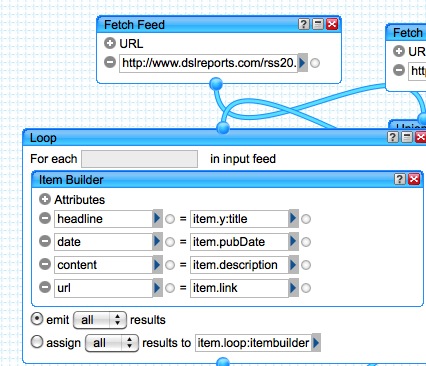I’m been trying to keep up with multiple stories (Sprint-Clearwire “4G”, Harbinger Capital’s nationwide LTE network , iPad) while running around tending other assignments. No, I don’t have much of a smartphone, more of a Bronze-age artifact that came with my Verizon plan. So how do I monitor my RSS feeds using my basic cell phone when I’m away from desk?
My only requirement was that I won’t compromise my core philosophy of applying minimal programming effort to the task at hand. I’m thankful to be living in the right era to help me stay true to my beliefs: they’re so many great software components and productivity tools available that it’s possible to glue together off-the-shelf parts to produce a useful digital time-saver with minimal perspiration.
As you know from a previous post, I’m excited about Twilio’s VoiceXML-lite hosting service. I will also reveal for the first time my love for a visual-oriented RSS mashup tool from Yahoo, called Pipes.
I just needed to glue a simple Pipes workflow to a little bit of PHP that calls Twilio’s SMS service and I’d have a poor man’s news notifier. Continue reading




 In the National Broadband Plan, there is hardly any mention of a wholesale or “unbundled” model of fiber-to-the-home. That’s unfortunate. There are many examples of successful deployments of fiber in which the physical part is built by the public sector (or through public-private partnerships), with private providers stepping in to resell access for voice, video, and data at the retail level. For a nitty-gritty description of one European city’s experience laying fiber under cobblestones and into canals, you can read about Amsterdam’s CityNet project,
In the National Broadband Plan, there is hardly any mention of a wholesale or “unbundled” model of fiber-to-the-home. That’s unfortunate. There are many examples of successful deployments of fiber in which the physical part is built by the public sector (or through public-private partnerships), with private providers stepping in to resell access for voice, video, and data at the retail level. For a nitty-gritty description of one European city’s experience laying fiber under cobblestones and into canals, you can read about Amsterdam’s CityNet project,  That’s not an Onion headline. But after perusing a few key sections of the officially released
That’s not an Onion headline. But after perusing a few key sections of the officially released